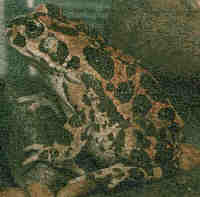Northern Leopard Frog
Rana pipiens
- Description:
- Slender greenish to brownish frog with dark spots which are usually edged with a
lighter color. It has a light stripe along its upper jaw and tends to grow to be
a little over 3 inches in length.
- Habitat:
- A large tank with half land, half water (which needs to be at least 6 inches deep)
is recommended. The temperature needs to be maximum 77°F (25°C),
reduced to about 59°F (15°C) at night. (see the Frog
Doctor for details on illness prevention.)
Read more information on this subject in the Housing Your Pet Frog
section.
- Diet:
- Feeds on various small
invertebrates...like crickets. (Variety is always recommended for frog feeding, and although
I know many seem to survive ok on just crickets most of the time - I hear this can eventually
take it's toll on frogs. See my page on Dealing with Crickets for more info.)
- Habits:
- These frogs need to hibernate for about 3 months: at
37-39°F (3-4°C).
Breeding is most likely to happen in outdoor enclosures
like backyard ponds.
- Miscellaneous Facts:
- These guys can be found in all kinds of
sites, from dirty cloudy marshlands to freshwater lakes. They come mostly from Southern
Canada and the northern half of the U.S. and have been classified into at least six
distinct species (that Ive heard of anyway.) All leopard frogs, however, can be treated
alike.
Mostly nocturnal creatures, these guys tend to take cover in the water when startled.
There are similar, related species of frogs that has similar care such as
the Southern Leopard frog Rana sphenocephala.
There is also,
however, one frog that looks deceptively similar called the Pickerel Frog
or Rana palustris. The Leopard Frog and the Pickerel Frog can be distinguished by the arrangement of their spots. The spots of the Pickerel Frog are almost square in pattern, while the Leopard Frog's spots are very irregular in shape and pattern.
The Pickerel frog's beautiful squarish dark markings
on its tannish back it looks very similar (though possibly somewhat more handsome) to most
leopard frogs, with the one crucial difference being that they have somewhat toxic skin,
and should therefore be housed alone as they can poison other frogs.
 This is a picture of Tom Buchanan's bufo regularis Leopard Toad , gender unknown,
estimated age 3-4 yrs.
This is a picture of Tom Buchanan's bufo regularis Leopard Toad , gender unknown,
estimated age 3-4 yrs.
Photo taken by Melvyn Esson of Flash! photography.
Listen to a sample of a Northern Leopard Frog call:
 205KB WAV file -- or -- 149KB AU file (from Animal Diversity Web.)
205KB WAV file -- or -- 149KB AU file (from Animal Diversity Web.)
Listen to a sample of a Southern Leopard Frog call:
 143KB WAV file -- or -- 104KB AU file (from Animal Diversity Web.)
143KB WAV file -- or -- 104KB AU file (from Animal Diversity Web.)
Learn how Leopard Frogs have adapted for Protection in this Weird Frog Fact Page.
Find out about some of the dangers Leopard Frogs are facing in Some Threatened Species section in the Save Our Frogs pages!
For more info, check out these links:
Back to Species Info Page.
Back to Frequently Asked Questions About Pet Frogs.
Back to FROGLAND.
 This is a picture of Tom Buchanan's bufo regularis Leopard Toad , gender unknown,
estimated age 3-4 yrs.
This is a picture of Tom Buchanan's bufo regularis Leopard Toad , gender unknown,
estimated age 3-4 yrs.![]() 205KB WAV file -- or -- 149KB AU file (from Animal Diversity Web.)
205KB WAV file -- or -- 149KB AU file (from Animal Diversity Web.) ![]() 143KB WAV file -- or -- 104KB AU file (from Animal Diversity Web.)
143KB WAV file -- or -- 104KB AU file (from Animal Diversity Web.)